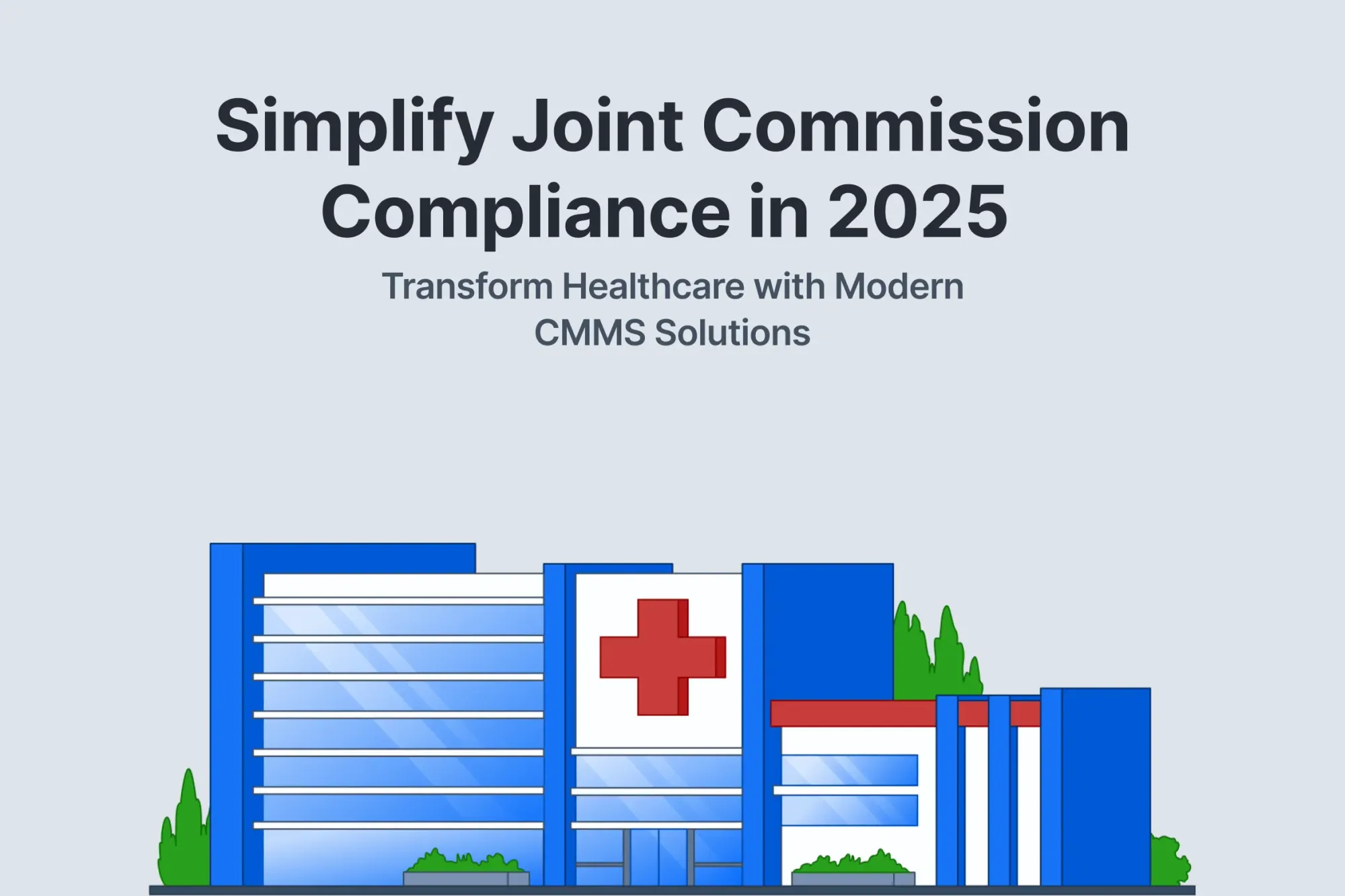Featured healthcare CMMS
How Modern CMMS Simplifies The Joint Commission Compliance for the Healthcare Industry

But it doesn’t have to be.
A modern healthcare CMMS makes compliance with The Joint Commission simple by automating processes like equipment inventory management, preventive maintenance scheduling, and audit documentation while prioritizing patient care.
It’s a win-win: your facility stays audit-ready, and patients receive safer, more reliable healthcare.
This article provides facility managers and HTM professionals with clear guidance on how to achieve The Joint Commission compliance with a modern CMMS solution, like Facilio, to reduce audit risks and ensure quality care.
What You’ll Learn:
- Regulatory Standards and Their Impact: Understand how The Joint Commission, NFPA, CMS, ASHE, and DME standards shape healthcare operations and why compliance is critical.
- Legacy Systems’ Shortfalls: Discover the pitfalls of manual and legacy CMMS limitations and how a modern healthcare CMMS overcomes them.
- Real-World Success: Explore a case study showing how modern CMMS ensures Joint Commission compliance with Facilio.
- Facilio’s Compliance Solutions: See how Facilio enables healthcare providers to achieve TJC compliance, maintain equipment and inventory, and deliver excellent patient care.
Understanding The Joint Commission and Other Critical Regulatory Standards

Understanding healthcare regulations is challenging for US hospitals, but it’s essential for delivering safe, high-quality patient care and to ensure everything from medical equipment to building safety meets strict requirements.
Let’s explore a few key standards:
- The Joint Commission (TJC):
- EC.02.04.01- Equipment Inventory Management:
Hospitals must maintain a complete and accurate inventory of all medical equipment. This includes tracking acquisition, usage, and retirement of devices to ensure every asset is accounted for and managed responsibly
- EC.02.04.03 - Preventive Maintenance :
TJC requires facilities to establish and follow a preventive maintenance schedule. This ensures that all critical equipment like ventilators, defibrillators, and imaging devices remain in optimal working conditions, reducing downtime and patient safety risks. Non-compliance, such as a ventilator failure, can result in TJC citations and penalties up to $75,000 in a 2024 Midwest hospital case.
- TJC Environment of Care (EOC) Standards:
EOC standards for healthcare ensure comprehensive safety across facilities. These standards promote a safe, functional, and supportive care environment across all hospital departments. They cover aspects like temperature control, lighting, emergency preparedness, and equipment safety protocols.
- Life Safety Code (LSC):
Aligned with the NFPA 101 guidelines, the LSC governs the design, construction, and maintenance of healthcare facilities to minimize fire risks and ensure safe evacuation in emergencies.
- National Fire Protection Association (NFPA):
- NFPA 99: The Health Care Facilities Code by NFPA ensures fire safety for medical equipment, electrical systems, and gas delivery to prevent hazards.
- NFPA 101: The Life Safety Code sets fire protection rules, requiring regular inspections of fire doors and exits to safeguard patients and staff.
- Centres for Medicare & Medicaid Services (CMS): CMS establishes Conditions of Participation, ensuring hospitals meet federal standards for Medicare/Medicaid reimbursement, including equipment reliability and documentation.
- American Society for Health Care Engineering (ASHE): ASHE provides guidelines for maintaining safe, efficient facilities, covering HVAC systems, emergency power, and energy management.
- Durable Medical Equipment (DME) Standards: These regulations ensure medical equipment like ventilators and wheelchairs are properly maintained for patient safety.
Additional Critical Standards:
- AAMI Standards: Offer technical benchmarks for Healthcare Technology Management (HTM) professionals to manage medical devices.
- OSHA Regulations: Enforce workplace safety, including safe equipment handling.
- ISO 55000: Provides a global framework for optimising asset management.
- FDA Regulations: Require traceable maintenance records for medical device safety.
- HIPAA: Ensures data security for equipment-related records integrated with CMMS for healthcare facility compliance.
Why is Compliance with Joint Commission and Other Standards Important For Hospitals?

Compliance with The Joint Commission, NFPA, CMS, ASHE, and DME standards is a must for US hospitals to ensure patient safety, financial stability, and operational excellence.
Here’s a breakdown:
- Ensuring Patient Safety Through Reliable Biomedical Assets:
Equipment failures can be catastrophic. A ventilator malfunction, violating TJC’s EC.02.04.03 for preventive maintenance or a defibrillator failure not only risks lives but can also lead to hefty fines and compliance penalties. Non-compliance directly jeopardizes patient safety, potentially causing critical failures during life-saving procedures.
- Protecting Finances by Avoiding Penalties:
Non-compliance is costly. Violating TJC’s EC.02.04.01 (equipment inventory) led a Midwest hospital to a $75,000 fine in 2024, along with a 90-day corrective plan disrupting operations. Breaking CMS Conditions of Participation can suspend Medicare/Medicaid funding, costing hospitals $2–5 million annually, up to 50% of revenue. Downtime from poor EC.02.04.03 compliance alone can cost $1,000–$10,000 hourly, compounding financial strain.
- Boosting Efficiency with Automated Workflows:
Manual compliance tracking, such as maintaining EC 02.04.01 inventory logs, consumes thousands of staff hours annually. This not only drains resources but also diverts attention from patient care and operational improvement, impacting overall hospital performance.
- Gaining Competitive Edge via Accreditation:
Accredited healthcare facilities benefit from higher reimbursement rates, attract top-tier physicians, and enjoy stronger patient trust. Joint Commission accreditation alone can boost revenue by 3-5%, positioning hospitals as leaders in healthcare quality and safety.
- Simplifying Multiple Standards in One System:
Navigating and adhering to multiple standards - TJC, NFPA 99 (fire safety), CMS, ASHE, and DME creates operational complexity. Failure to meet these standards risks fines, operational disruptions, and reputational damage, undermining an organization’s credibility and patient trust.
- Reducing Legal Risks with Audit Trails:
Non-compliance increases legal exposure. In cases of equipment failure, such as violating FDA regulations, comprehensive maintenance records can be the difference between a dismissed lawsuit and a million-dollar settlement. A lack of documentation leaves hospitals vulnerable to litigation and reputational harm.
Where legacy CMMS falls short: Why Hospitals Need an Urgent Upgrade?

Most hospitals rely on legacy CMMS systems, but these outdated tools fail to meet today’s compliance requirements. This creates operational gaps that endanger patient care, jeopardize audits, and leave hospitals vulnerable to penalties and reputational damage.
Here’s why an upgrade is essential:
- Limited Reporting and Insights: Legacy CMMS platforms function more like basic data repositories, offering minimal and generic reports that aren’t customised to specific departmental needs. Without the built-in reporting, decision-making often happens without ready insights, leaving hospitals exposed to compliance risks and operational blind spots. Extracting meaningful data requires hiring external experts to build dashboards using tools like Power BI, which adds unnecessary cost and delays.
- Rigid Configurations That Disrupt Operations: Legacy systems come with rigid workflows and limited customisation options for approvals, inspection forms, and compliance processes. Hospitals are forced to adapt their operations to the tool instead of the other way around, leading to inefficiencies and potential compliance breaches. Customising workflows requires costly third-party IT services, consuming both time and resources while adding another layer of complexity.
- Lacking Real-Time Monitoring: Legacy systems miss crucial real-time monitoring capabilities and IOT integrations, risking equipment failures that violate TJC’s EC.02.04.03 for preventive maintenance. This compromises patient safety and can lead to compliance breaches, operational disruptions, and financial penalties.
- Hampering Staff with Outdated Interfaces: Clunky, outdated interfaces slow down staff, leading to errors in equipment inventory management (EC.02.04.01). This affects efficiency, holding back audit readiness.
- Failing to Adapt to New Regulations: Legacy systems lack scalability for 2025’s stricter TJC and CMS rules, affecting compliance and holding back accreditation. This exposes hospitals to compliance failures, reimbursement rates, and patient trust.
- Delaying Audits with Manual Reports: Manual reporting processes in legacy systems delay compliance documentation, affecting audit success and disrupting operations. This can result in corrective action plans, fines, and reputational damage
Case Study: Hospital Compliance with Joint Commission using Facilio
A 500-bed hospital in Texas faced serious Joint Commission compliance challenges with its fragmented, legacy CMMS. During audits, TJC flagged two critical issues: incomplete equipment inventories (EC.02.04.01) and inconsistent Alternative Equipment Maintenance (AEM) schedules (EC.02.04.03). These gaps threatened $100,000 in fines and potential accreditation loss, putting patient safety and operational efficiency at risk.
Why Did the Issue Happen?
The hospital's legacy system couldn’t effectively track over 6,000 devices and their maintenance histories. Without a connected platform, assets frequently went "missing", resulting in 20% of equipment being "unable to locate" during audits. Maintenance schedules were managed manually, with no automated triggers or alerts for recurring failures. Staff often relied on outdated paper records or disconnected databases, leading to poor visibility and delayed responses.
How Facilio Could Help: Modern CMMS Capabilities
A modern CMMS like Facilio would centralise all asset tracking and compliance workflows into one unified platform.
- Using RFID, QR codes, or barcodes, each asset would carry a unique identifier, enabling instant scanning to access its complete maintenance history, location (including building and floor), and recent repair logs.
- Staff could quickly identify recurring issues, for example, if a ventilator had been repaired every month over the past six months, AEM schedules could be automatically triggered for a more proactive approach. Inventory management would also improve dramatically, reducing "unable to locate" errors and enabling real-time asset visibility.
With Facilio’s purpose-built healthcare CMMS, Hospital X could transform its compliance efforts from reactive to proactive, safeguarding patient care and avoiding costly penalties.
How Facilio’s Healthcare CMMS Powers Compliance

Facilio’s Connected CMMS solves legacy pain points with advanced features, ensuring compliance with TJC, NFPA, CMS, ASHE, and DME standards.
- Intelligent Equipment Inventory Management:
Lost equipment? Not with Facilio. It uses RFID, QR, and barcode tracking to give every asset a unique code, enabling instant access to its full history and location. This accuracy supports TJC’s EC.02.04.01 compliance and streamlines audits
- Proactive Preventive Maintenance & AEM Scheduling
Maintenance plans are configured based on each asset’s routine - quarterly or as needed, helping prioritize high-risk equipment and ensuring compliance with NFPA 99 and EC.02.04.03 standards.
- Automated, Customizable Reporting
Generates audit-ready, customised reports automatically with accurate time-stamped logs, reducing compliance prep time by up to 80% and supporting better data-driven decisions
- Flexible Workflow & Inspection Form Configuration
Customize the workflows, approvals, and inspection forms to fit your hospital’s unique processes, no costly IT service needed, so your operations drive the tool, not the other way around.
- Real-Time Monitoring & Instant Alerts
IoT-enabled sensors provide live status updates and trigger alerts for preventive maintenance or faults, minimising downtime and enhancing patient safety.
- Comprehensive Regulatory Alignment
Helps achieve The Joint Commission, NFPA, CMS, ASHE, and DME standards while ensuring HIPAA-compliant data handling for a unified compliance strategy.
Table data: Projected Compliance Impact with Facilio’s Healthcare CMMS
Lead with Facilio’s Modern CMMS to Stay Compliant in 2025
Our healthcare CMMS ensures compliance with Joint Commission, NFPA, CMS, ASHE, and DME standards, minimising audit risks while boosting patient safety. By automating workflows and using IoT, Facilio makes healthcare maintenance management a simpler process.
Stay ahead in 2025 with Facilio’s modern, Connected CMMS, aimed to help your hospitals stay compliant with The Joint Commission, maintain accreditation and optimise operations and avoid costly penalties.
Request a demo today to stay audit-ready and patient-focused.
